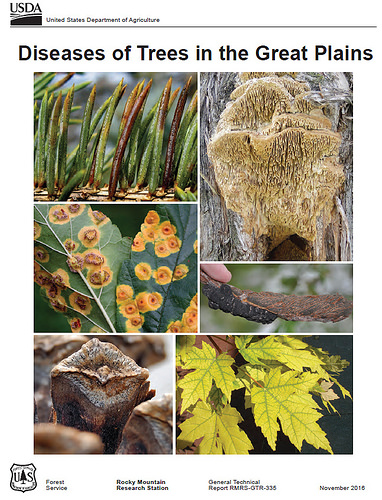It began as a causal conversation in a hotel lobby in Kansas. After a day of discussions during the annual meeting of the Great Plains Tree Pest Council, the after-hours talk turned to the idea of updating the 1986 Diseases of Trees in the Great Plains manual.
The manual had been a staple for years, riding along in many a Plains forester’s truck and used in pathology labs across the region. With a pen and notebook in hand, Council Secretary Aaron Bergdahl started jotting down notes around what the updated book might look like; the next thing he knew, he was nominated to co-coordinate its production.
That fateful conversation stimulated a four-year and 229-page, fully-updated, color publication, with double the number of tree species and diseases from the original greatly benefiting those doing research. The new Diseases of Trees in the Great Plains would not have been possible without the cooperation and comradery found amongst the Council’s members.
What’s unique about this story, and the book that was a result of it, is the transition between generations, and the knowledge sharing and mentoring often lost in today’s fast-paced society. In the 1980s when the first book was written there were twice as many people working in tree health in the Plains, and today the issues are even more complex with fewer people to address them.
The Plain’s environment is a tough place to grow trees and keep them healthy so the updated manual will benefit the region as a whole because knowing how to detect diseases early on can prevent loss of trees in both rural and urban areas.
In the Plains, people don’t take trees for granted because trees are and have always been important to the quality of life. In fact, there are strong community forests, municipal forests, agroforestry programs and conservation programs for trees.
Alison Hill, Program Manager with the U.S. Forest Service Rocky Mountain Research Station, was asked to co-coordinate the effort and willingly lent her expertise to the process of producing the update. The diverse group -- people from state, federal and local government agencies, universities and more -- came together to deliver knowledge and train the next generation of specialists to help the trees of the Great Plains which benefits the entire region.
As the Council members were gathered in that hotel lobby they realized the need to capitalize on the expertise of the senior scientists before they retired. The original authors that were still active in the field were asked to work on the book with newer pathologists and entomologists.
This book is testament to the commitment to healthy trees and forests in the Great Plains and to the unique collaboration of the members of the Great Plains Tree Pest Council.

